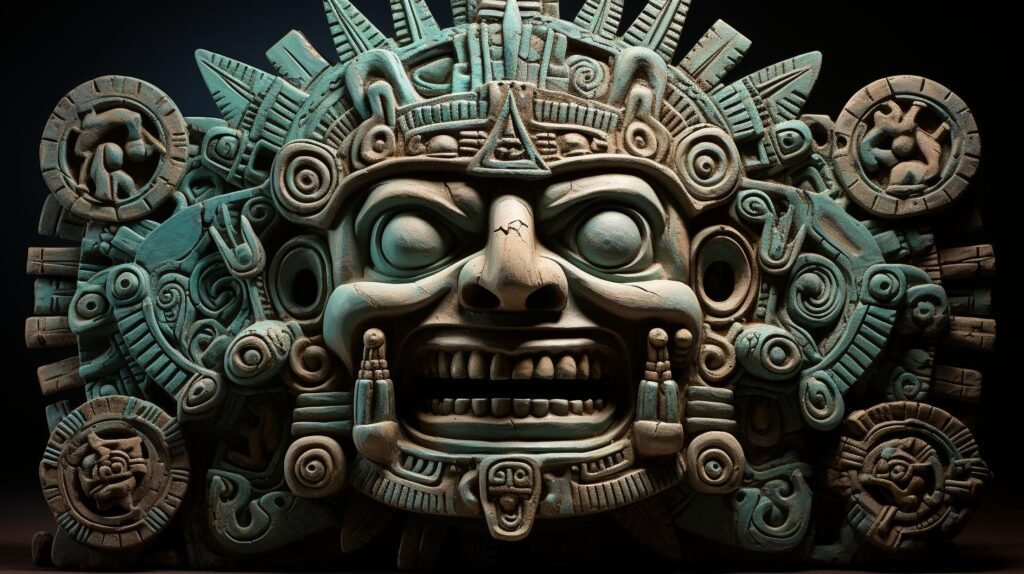The ancient Maya civilization had a rich and complex pantheon of gods and goddesses, each with their own unique attributes and roles. One of the most revered and prominent deities in the Maya mythology was Kinich Ahau, the sun god. This article will explore the various aspects of Kinich Ahau, including his appearance, associations, shared attributes with other deities, and his role in Maya mythology and ritual. Through a comprehensive examination of this fascinating figure, we will gain a deeper understanding of the importance of Kinich Ahau in Maya culture.
Kinich Ahau: The Sun God’s Appearance and Associations
Kinich Ahau was commonly depicted as a middle-aged man with distinct facial features. He had an aquiline nose, which gave him an air of authority, and large square eyes that symbolized his ability to see everything happening in the world. One notable aspect of Kinich Ahau’s appearance was his filed incisor tooth, which further emphasized his divine status.
As the sun god, Kinich Ahau was associated with the eastern paradise, a celestial realm often described as the dwelling place of the gods. In some depictions, he was shown with wings or wearing headdresses adorned with feathers, indicating his connection with the heavenly realm. Additionally, Kinich Ahau had the ability to transform into a water bird or a young man paddling a canoe, symbolizing his control over the water element.
When depicted as a king, Kinich Ahau was often shown seated on a throne cushion or carrying a ceremonial bar, symbolizing his divine authority and rulership. This association with royalty leads us to the next aspect of Kinich Ahau’s significance.
Kinich Ahau: The Connection to the Maya Kings
The Maya kings, who held immense power and were seen as divine rulers, were often assimilated to Kinich Ahau. They were believed to embody his solar aspect and were considered his earthly representatives. This assimilation to the sun god elevated the status of the Maya kings and emphasized their divinity.
Furthermore, the concept of apotheosis played a crucial role in the connection between Kinich Ahau and the Maya kings. Apotheosis refers to the idea of a human being attaining divine status after death. The Maya kings were believed to achieve apotheosis and become one with Kinich Ahau upon their passing, ensuring eternal life and a continued connection to the divine realm.
Another significant aspect of Kinich Ahau’s association with the Maya kings was his role as the patron of one of the four years in the 52-year cycle known as Itzamna. Itzamna was considered a sacred time period, and the association with Kinich Ahau elevated its importance. The number four, which represented the years in the cycle, held great significance in Maya culture.
Kinich Ahau’s Shared Attributes with Other Deities
While Kinich Ahau was a prominent deity in his own right, he also shared attributes with other important deities in Maya mythology. One such deity was the Jaguar God of the Underworld, who, like Kinich Ahau, was associated with rulership and power. This shared attribute emphasized the cyclical nature of life and death in Maya belief systems.
Additionally, Kinich Ahau shared attributes with an ocean deity, underscoring his dominion over both the celestial and aquatic realms. This shared attribute showcased the interconnectedness of different natural elements and highlighted the complexity of Maya cosmology.
Kinich Ahau in Mythology and Ritual
While much is known about Kinich Ahau’s appearance and associations, there is limited information available regarding his specific role in mythology and ritual. However, there are some significant references to his mythological persona in certain texts and codices.
In the southern Lacandon narrative, Kinich Ahau is said to bring about the end of the world. According to this prophecy, he descends from the sky with his jaguars, who devour mankind, signifying the destruction of the present world order. This narrative demonstrates the power and authority attributed to Kinich Ahau, as well as the belief in cyclical cosmological cycles.
The Dresden Codex, an ancient Maya manuscript, also provides insights into Kinich Ahau’s role within ritual activities. This codex focuses on various ritual matters, such as divination and astronomy. Kinich Ahau’s appearance in the Dresden Codex signifies his importance in these critical aspects of Maya religious practices.
Conclusion
As we delve deeper into the complexities of Maya mythology, Kinich Ahau emerges as a central figure with immense significance. His association with the sun, the eastern paradise, and his shared attributes with other deities highlight his pivotal role in Maya cosmology. The connections between Kinich Ahau and the Maya kings further exemplify the intricate interplay between religion, rulership, and divinity. While there are still aspects of Kinich Ahau’s role in mythology and ritual that remain shrouded in mystery, the information available provides valuable insights into the beliefs and practices of the ancient Maya civilization.
